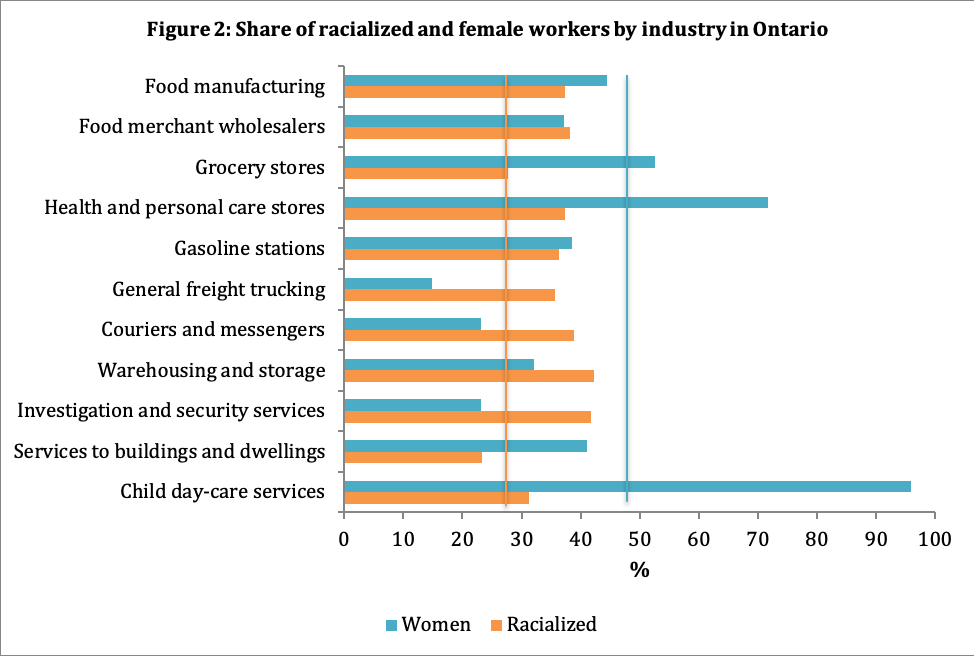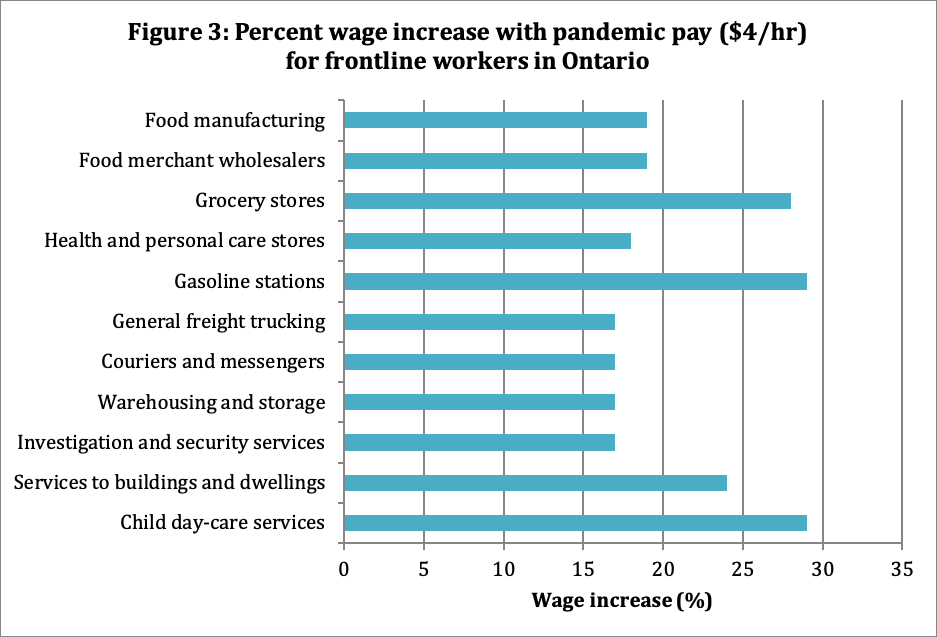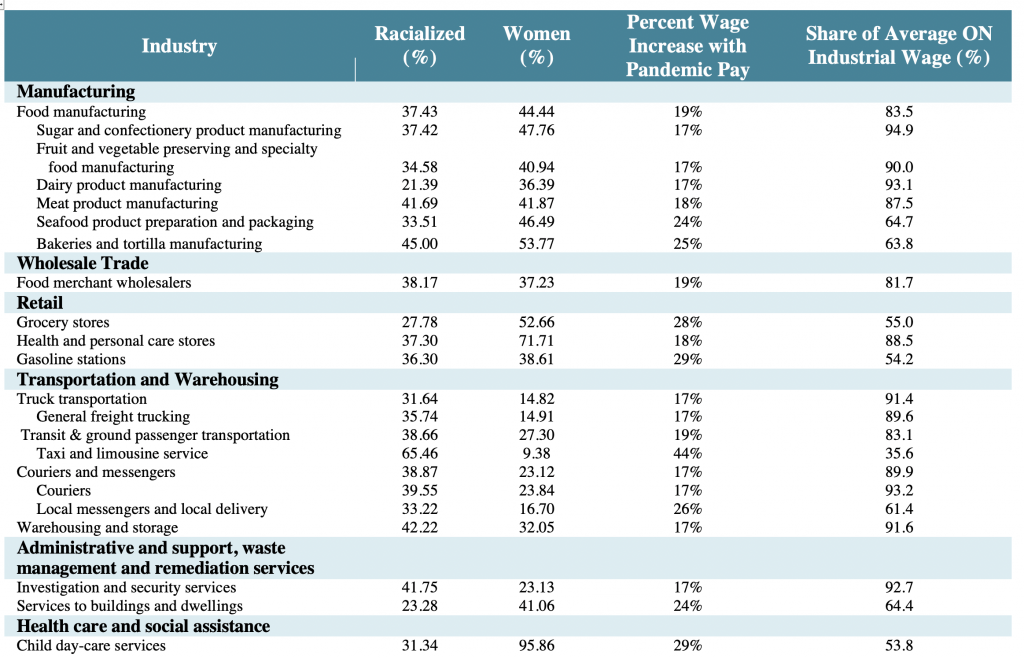Workers on the front lines of our economy stock our grocery shelves, pack boxes in warehouses, and deliver our food. As COVID-19 rages on, they are facing dangerous working conditions with inadequate personal protective equipment, low wages, and a high stress load.
Frontline workers did not sign up to be “heroes” amidst a global pandemic. But they need pay that is proportionate to the profound personal risk they are undertaking on our behalf by continuing to work in the proverbial line of fire.
Just over a week ago, the Ford government topped up the hourly wages of 350,000 frontline workers in three sectors—health care and long-term care, social services, and corrections—by $4. The “pandemic pay premium” would only be accessible to those in “direct contact” with the virus, according to Premier Ford, who called it a “small token of our appreciation.”
Naturally, many asked: Who is excluded? When paramedics, respiratory therapists, and other health care sector workers voiced discontent over being excluded from the wage boost, the pandemic pay was later expanded to include them.
As pressure to re-open segments of the economy mounts, it’s worth considering who is indeed in “direct contact” with the virus and whose labour keeps our society afloat.
Not everyone has the luxury of working in a space with physical distancing. Data visualization of occupation by physical proximity and disease exposure shows that grocery clerks, cleaners, and bus drivers are just some of the workers who have a greater risk of being exposed to COVID-19. These workers are not receiving pandemic pay.
Taken to an extreme is Alberta’s Cargill meat plant, where a racialized and migrant workforce stands should-to-shoulder to process the beef we eat. At least 1,510 of the COVID-19 cases in Alberta are tied to this plant, with 917 workers sick and one tragically dead. Despite 85% of the workers being afraid to go into work this week, the Cargill meat plant has chosen to re-open.
Here in Ontario, Brampton’s Maple Leaf Foods poultry plant was shut down in early April when three workers tested positive for COVID-19. While Maple Leaf Foods reports a 12.8% increase in sales revenue in the first quarter of 2020 and its CEO, Michael H. McCain, has a net worth of $4.15 billion, hourly workers have only received an additional $80 per week.
Loblaws, too, saw an additional $751 million in sales revenue in the first three weeks of March due to a surge in demand—a trend of increased revenues also seen in Metro, Sobeys, and Amazon. The Weston family remains the third-richest family in the country (net worth: $7 billion), and Galen Weston, Jr.’s company continues to be known for lobbying against raising the minimum wage to $15 and colluding with other retailers for 14 years to raise the price of bread.
While workers employed by Loblaws and other big grocery chains receive an extra $2 per hour, they continue to voice concerns about their working conditions and wages. Meanwhile, workplace health-and-safety refusals in Ontario have reached a fever pitch, yet not a single one has been upheld by the Ministry of Labour out of the 200 filed.
To illustrate the implications of pandemic pay for Ontario’s frontline workers outside of the health care sector, as well as their social demographics, we used the 2019 Labour Force Survey and the 2016 Census. The census is the only available data source that provides employment data both by detailed industry and by race.
How much do workers in frontline industries earn?
Workers in frontline industries earn less than the average hourly wage across all industries (Figure 1). The earnings in these industries get to a high of 93% for workers in investigation and security services—a sector that has ramped up its hiring as companies invest in more security. Earnings reach a low of 54% the average hourly wage for workers in child day-care services and gasoline stations, as well as 55% for grocery store workers.
 Source: Statistics Canada. Table 14-10-0206-01 Average hourly earnings for employees paid by the hour, by industry, annual. Labour Force Survey, 2019.
Source: Statistics Canada. Table 14-10-0206-01 Average hourly earnings for employees paid by the hour, by industry, annual. Labour Force Survey, 2019.
Who works in frontline industries?
Racialized workers are over-represented in these low-wage industries (Figure 2). While racialized workers are 27% of Ontario’s total workforce, they range from 23% of workers delivering services to buildings and dwellings (e.g., cleaners, landscapers)[1] to 42% of warehousing and storage workers, as well as those in investigation and security services.
Within the food manufacturing sector, 45% of workers in bakeries and tortilla manufacturing, and 42% of those in meat product manufacturing, are racialized (see Appendix). Given the news that at least four taxi and limousine drivers at Pearson airport have died recently due to COVID-19, it’s important to note that nearly two-thirds (65%) of workers in this industry are also racialized.
Women make up 49% of Ontario’s total workforce. The vast majority of health care workers, such as personal support workers and nurses, are women. However, workers in non-health-care frontline sectors are primarily male-dominated, with the exception of workers in grocery stores, health and personal care stores, and child day-care services (Figure 2).
 Source: Statistics Canada - 2016 Census. Catalogue number 98-400-X2016360.
Source: Statistics Canada - 2016 Census. Catalogue number 98-400-X2016360.
COVID-19 is extremely severe for the elderly. While 22% of Ontario’s total workforce is aged 55 or over, some industries maintain a disproportionately larger share of workers in this age group: food manufacturing (24%), truck transportation (30%), couriers and messengers (26%), investigation and security services (25%), and services to buildings and dwellings (26%).
To what extent would pandemic pay support frontline workers?
A pandemic pay of an extra $4 per hour would be a substantive addition to the pockets of low-wage workers in frontline industries (Figure 3). At the low end, the wage boost would raise hourly wages by 17% for workers in health and personal care stores, warehousing and storage, couriers and messengers, and general freight trucking. At the high end, it would improve hourly wages for workers in child day-care services and gasoline stations by 29%. Within food manufacturing, this top-up would be especially significant for workers in bakeries and tortilla manufacturing, resulting in a 25% increase in their hourly wage.
 Source: Statistics Canada. Table 14-10-0206-01 Average hourly earnings for employees paid by the hour, by industry, annual. Labour Force Survey, 2019.
Source: Statistics Canada. Table 14-10-0206-01 Average hourly earnings for employees paid by the hour, by industry, annual. Labour Force Survey, 2019.
Pay frontline workers what they’re worth: a lot
Early on in the pandemic, several private sector employers ranging from food manufacturers to retail giants set an informal standard of a “hazard pay” of $2 per hour. A month later, the Ford government deemed $4 per hour to be an appropriate degree of additional compensation for workers in direct contact with the virus.
Yet the data, and indeed common sense, tell us that many segments of workers, such as those described above, continue to directly face this lethal virus without the necessary material supports. And many more will be forced to join them as calls for re-opening workplaces get louder.
So, we are left with the question: how much is the labour of all frontline workers worth?
If our provincial government can set the bar at $4 per hour, then surely employers—especially corporate giants turning a profit during a pandemic—can find a way to pay workers what their labour is worth: our collective safety and workers’ dignity. That is, at least $4 more per hour, if not considerably more.
As the pandemic continues, ensuring that frontline workers have decent wages, as well as 21 days of paid sick leave and safe working conditions, is the least that we, as a province can do.
[1] The occupational category of light duty cleaners (NOCS6731) is 33.7% racialized. By contrast, the industrial category of “services to buildings and dwellings” has a lower share of racialized workers because it includes other workers such as landscapers.
Simran Dhunna was a recent CCPA placement student and is completing her MPH in Epidemiology at the University of Toronto. She is also an organizer with Climate Justice Toronto and Peel.
Appendix







